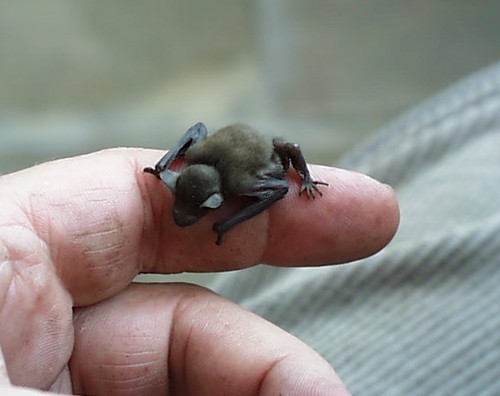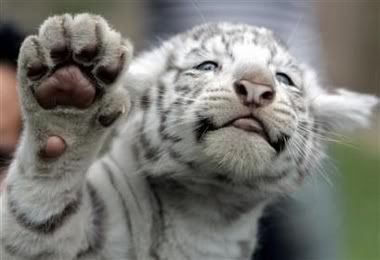Wednesday, February 28, 2007
Tuesday, February 27, 2007
Honeybees Vanish, Leaving Keepers in Peril
 David Bradshaw has endured countless stings during his life as a beekeeper, but he got the shock of his career when he opened his boxes last month and found half of his 100 million bees missing.
In 24 states throughout the country, beekeepers have gone through similar shocks as their bees have been disappearing inexplicably at an alarming rate, threatening not only their livelihoods but also the production of numerous crops, including California almonds, one of the nation’s most profitable.
“I have never seen anything like it,” Mr. Bradshaw, 50, said from an almond orchard here beginning to bloom. “Box after box after box are just empty. There’s nobody home.”
The sudden mysterious losses are highlighting the critical link that honeybees play in the long chain that gets fruit and vegetables to supermarkets and dinner tables across the country.
Beekeepers have fought regional bee crises before, but this is the first national affliction.
David Bradshaw has endured countless stings during his life as a beekeeper, but he got the shock of his career when he opened his boxes last month and found half of his 100 million bees missing.
In 24 states throughout the country, beekeepers have gone through similar shocks as their bees have been disappearing inexplicably at an alarming rate, threatening not only their livelihoods but also the production of numerous crops, including California almonds, one of the nation’s most profitable.
“I have never seen anything like it,” Mr. Bradshaw, 50, said from an almond orchard here beginning to bloom. “Box after box after box are just empty. There’s nobody home.”
The sudden mysterious losses are highlighting the critical link that honeybees play in the long chain that gets fruit and vegetables to supermarkets and dinner tables across the country.
Beekeepers have fought regional bee crises before, but this is the first national affliction.
Five-Legged Lamb Born In Kansas
 A five-legged lamb was born last week in Miami County, Kan.
The lamb, which is owned by the Evans family in Osawatomie, has a fifth leg sticking out of its abdomen; the leg has a bone in it.
"Isn't this the weirdest thing you've ever seen?" Michelle Evans said. "We didn't know if it would walk, but it got right up and it's doing great."
A five-legged lamb was born last week in Miami County, Kan.
The lamb, which is owned by the Evans family in Osawatomie, has a fifth leg sticking out of its abdomen; the leg has a bone in it.
"Isn't this the weirdest thing you've ever seen?" Michelle Evans said. "We didn't know if it would walk, but it got right up and it's doing great."
Man says dog saved him from black bear
Jason Schindler says he wouldn't be alive if it were not for his dog, Dude. The 27-year-old rural Cataract man said the 8-year-old mixed-breed hound jumped between him and an attacking black bear Thursday night, saving his life but giving up his own. The animal sustained at least 28 puncture wounds to his chest and neck, he said. "I'd hate for someone else's dog to go through what mine did," he said. Schindler and his wife, Kimberly, buried the dog with a blanket and pillow the next day, using a rented jackhammer to dig the grave in the frozen soil. He said he heard the dog yelping loudly Thursday after dark and went out to see what was happening. Suddenly, "all I saw was this dark thing lunging at me," Schindler said. But his dog jumped between the two and was quickly snatched up in the bear's jaw, he said.
Not everyone's pets are warm and fuzzy
Robert and Beth Hall of Sheboygan don't have your run-of-the-mill house pets.
Among their menagerie of reptiles and invertebrates are 38 snakes, including a 17-foot Burmese python, along with two alligators, a tarantula, 16 scorpions, a green iguana, an Australian tegu, a Nile monitor and three tortoises, one weighing 50 pounds.
"We first started out with the tarantulas because they do take up less space," Beth Hall, 23, said. "Then, our first few reptiles that we had, we had a green iguana and a bearded dragon."
The Halls got more animals as people learned about the animals they had.
"Then, they were like, 'Oh, I can't keep my snake anymore. Do you mind if I drop it off at your house?'" Beth said.
A real life Dr Doolittle
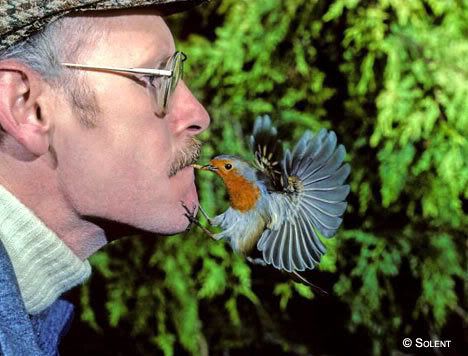 Bird lover Dennis Bright has become a real life Dr Doolittle by taming this plucky Robin so it dares to land on his chin - and eat a worm from his mouth.
Dennis, who has been a wildlife photographer for 20 years, says Robins are naturally tame birds and can be tempted by a free feed of mealworm.
And he says he even talks to the birds and lets them fly around his house so they can get used to him.
He said: "Taming a Robin is actually quite simple - anyone can do it. The secret is that they will sell their soul for a mealworm!
(via)
Bird lover Dennis Bright has become a real life Dr Doolittle by taming this plucky Robin so it dares to land on his chin - and eat a worm from his mouth.
Dennis, who has been a wildlife photographer for 20 years, says Robins are naturally tame birds and can be tempted by a free feed of mealworm.
And he says he even talks to the birds and lets them fly around his house so they can get used to him.
He said: "Taming a Robin is actually quite simple - anyone can do it. The secret is that they will sell their soul for a mealworm!
(via)
Monday, February 26, 2007
Tourists buy live animals.. to throw to tigers
This is just despicable - reading it turned my stomach . . . EYES rolling and squealing with fear, the cow is forced from the back of a moving pick-up truck into the dirt. There is an explosion of dust, blood and flashing cameras as an ambush of tigers moves in for the kill, tearing great strips off the animal's back as it struggles for a second, then goes still, bar the odd twitch. A minute later there is little left of the ton-weight heifer except a scrap of skin, a mess of bones and a puddle of blood. But this is not some wild savannah. Welcome instead to China's latest tourist craze - paying up to £120 a time to feed live animals to ravenous Siberian tigers. From four packed buses goggle-eyed tourists shoot roll after roll of film, and even clap. One Westerner waves a roll of notes at the tour guide, excitedly gesturing at the bizarre menu pinned to the wall. . . . [ pictures ] Last year, Wang Wei, of China's Wildlife Conservation Department, promised to "put an end to shows of feeding beasts of prey with live animals". But, today, it is still very much business as usual.
Australia rocked by 'lesbian' koala revelation
Female koalas indulge in lesbian "sex sessions", rejecting male suitors and attempting to mate with each other, sometimes up to five at a time, according to researchers. The furry, eucalyptus-eating creatures appear to develop this tendency for same-sex liaisons when they are in captivity. In the wild, they remain heterosexual. Scientists monitoring the marsupials with digital cameras counted three homosexual interactions for every heterosexual one. "Some females rejected the advances of males that were in their enclosures, only to become willing participants in homosexual encounters immediately after," say the researchers.
Rhapsody in Blue
 For most of the year, the Karner blue butterfly exists as a tiny, dimpled white egg. But as winter days lengthen into spring, the life inside begins to stir, and soon a pale green caterpillar emerges. It feeds, then cloaks itself in a chrysalis. And then, for one brief week, the Karner blue is on the wing.
Or, a wing and a prayer.
For decades, the butterfly with the fleeting appearance was on the verge of becoming a fleeting species as its oak savannas and pine barrens disappeared. Now, with efforts to restore its preferred habitat and raise the butterflies in captivity, the Karner blue’s future is decidedly more upbeat.
The rare blue butterfly lives for the wild blue lupine. When Karner eggs hatch in April, lint-sized caterpillars emerge to feed on the leaves of the newly sprouted plant. Nothing else will do. And when the mature butterflies are looking to lay eggs for a second brood, again, they’ve only got eyes for lupine.
For most of the year, the Karner blue butterfly exists as a tiny, dimpled white egg. But as winter days lengthen into spring, the life inside begins to stir, and soon a pale green caterpillar emerges. It feeds, then cloaks itself in a chrysalis. And then, for one brief week, the Karner blue is on the wing.
Or, a wing and a prayer.
For decades, the butterfly with the fleeting appearance was on the verge of becoming a fleeting species as its oak savannas and pine barrens disappeared. Now, with efforts to restore its preferred habitat and raise the butterflies in captivity, the Karner blue’s future is decidedly more upbeat.
The rare blue butterfly lives for the wild blue lupine. When Karner eggs hatch in April, lint-sized caterpillars emerge to feed on the leaves of the newly sprouted plant. Nothing else will do. And when the mature butterflies are looking to lay eggs for a second brood, again, they’ve only got eyes for lupine.
Sunday, February 25, 2007
Introduction to Bats
This website, batdetective.com, has been designed to educate all age groups on the life styles of bats. These creatures are probably the most misunderstood creatures in the world. They come out while we sleep and are back in their roosts long before we are up and about in the morning. Most people only get to see a fleeting glimpse of a shadow that shoots by in the twilight. In Africa tribes believe that bats bring bad omens while in China bats bring good luck and can be seen embroidered on the gowns of emperors. The Chinese word ‘FU’ can mean bat or good luck depending on its pronunciation.
Saturday, February 24, 2007
USA Rawhide Retriever Rolls
comfy cozy puppy

Kangaroo Desk Organizer
 "Kangaroo" is a fine message center, holding papers and pencils or a cell phone in its pocket and messages in its mouth. - momastore.org
"Kangaroo" is a fine message center, holding papers and pencils or a cell phone in its pocket and messages in its mouth. - momastore.org
Kid's Pug Bank
Friday, February 23, 2007
White Bengal tiger cub
Raccoon dogs used for fur
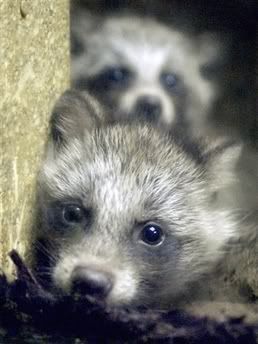 Two raccoon dog pups, and a third unseen pup, members of the canine family who are native to inland China, huddle together at the Henry Doorly Zoo in Omaha, Neb., Thursday, Aug. 26, 2004.
An animal advocacy group says an investigation has found coats - some with designer labels, some at higher-end retailers - with fur from man's best friend. Although raccoon dogs aren't kept as pets and importing their fur is not illegal, activists argue they are still a type of dog. Fur from domestic dogs has also been found on coats even though the fur was advertised as fake. (AP Photo/Nati Harnik, File)
Two raccoon dog pups, and a third unseen pup, members of the canine family who are native to inland China, huddle together at the Henry Doorly Zoo in Omaha, Neb., Thursday, Aug. 26, 2004.
An animal advocacy group says an investigation has found coats - some with designer labels, some at higher-end retailers - with fur from man's best friend. Although raccoon dogs aren't kept as pets and importing their fur is not illegal, activists argue they are still a type of dog. Fur from domestic dogs has also been found on coats even though the fur was advertised as fake. (AP Photo/Nati Harnik, File)
Smooshi and Phil
 Phil works as a Marine Mammal Trainer. In 2004, Smooshi, a then 18 month old baby walrus, arrived at Marineland from Russia weighing approximately 198lbs. The two would spend many hours playing, eating … even napping together, and an immediate bond was established.
Fast forward to today (3 years and 600lbs later) and the bond remains unchanged. Smooshi will follow Phil absolutely anywhere often looking up to him for approval. They often take walks around the park or just play in the snow. This is a unique bond that is sure to amaze and touch you… it truly is “something you gotta see”.
(via)
Phil works as a Marine Mammal Trainer. In 2004, Smooshi, a then 18 month old baby walrus, arrived at Marineland from Russia weighing approximately 198lbs. The two would spend many hours playing, eating … even napping together, and an immediate bond was established.
Fast forward to today (3 years and 600lbs later) and the bond remains unchanged. Smooshi will follow Phil absolutely anywhere often looking up to him for approval. They often take walks around the park or just play in the snow. This is a unique bond that is sure to amaze and touch you… it truly is “something you gotta see”.
(via)
Thursday, February 22, 2007
Long-captive manatees returned to wild
 ORANGE CITY, Fla. -- Two manatees that had been at an Ohio zoo were released into the wild on Tuesday at Blue Spring State Park in Volusia County.
Gene, who weighs about 1,900 pounds, had been in captivity for 30 years. When he was 2, he was hit by a boat and cut by its propeller in Brevard County.
Gene's son, Dundee, who weighs about 1,300 pounds, was released with his father. Dundee acted a little childish when workers tried to turn him on his stomach. He showed off for the waiting pod in the water and the crowd was delighted.
Researchers hope that Gene and Dundee will thrive in the wild. They have installed global position system-like devices in the manatees to monitor their progress.
"We're monitering him to make sure he is adapting, and if he is not, then we can intervene. We also do routine health assessments," said Monica Ross, a Wildlife Trust research scientist.
It was a bittersweet parting for some in the crowd, including Marvin Darvey, who watched over Gene in the Ohio zoo for more than six years.
"I am glad that he can get out there and meet some girls and maybe make some babies because that's the whole object," said Darvey.
ORANGE CITY, Fla. -- Two manatees that had been at an Ohio zoo were released into the wild on Tuesday at Blue Spring State Park in Volusia County.
Gene, who weighs about 1,900 pounds, had been in captivity for 30 years. When he was 2, he was hit by a boat and cut by its propeller in Brevard County.
Gene's son, Dundee, who weighs about 1,300 pounds, was released with his father. Dundee acted a little childish when workers tried to turn him on his stomach. He showed off for the waiting pod in the water and the crowd was delighted.
Researchers hope that Gene and Dundee will thrive in the wild. They have installed global position system-like devices in the manatees to monitor their progress.
"We're monitering him to make sure he is adapting, and if he is not, then we can intervene. We also do routine health assessments," said Monica Ross, a Wildlife Trust research scientist.
It was a bittersweet parting for some in the crowd, including Marvin Darvey, who watched over Gene in the Ohio zoo for more than six years.
"I am glad that he can get out there and meet some girls and maybe make some babies because that's the whole object," said Darvey.
Wolf dogs find haven in New Hampshire sanctuary
 What happens, finally, is you turn a corner – this one being deep in New Hampshire at the bottom of a frost-heaved dirt road over a Western ridge. There is a sign there, crude letters on simple planks. "Loki Clan Wolf Refuge," it says. And you turn that corner and then you see one. You see a wolf. Her name, you learn later, is Wayah. You're here to meet the man who saved her.
In a minute that man, Fred Keating, will watch you watching Wayah, and will begin telling you about her. To begin with, she is not entirely a wolf, despite everything your senses tell you. She's a wolf dog, a mix made by breeding wolves in captivity with dogs. (Wolves won't mate with dogs in the wild.) In most states, Wayah is illegal; in the rest, she's a bad idea for all but a very, very few. "People get them, thinking they'll be pets," Mr. Keating says, "dogs, but cooler. But they're not pets. They're wolves. Doesn't matter if their wolf blood is only 1 percent – that makes them as smart as a 12-year-old human, compared with dogs who are like 3-month-old infants. They're wolves, and that's how they act."
What happens, finally, is you turn a corner – this one being deep in New Hampshire at the bottom of a frost-heaved dirt road over a Western ridge. There is a sign there, crude letters on simple planks. "Loki Clan Wolf Refuge," it says. And you turn that corner and then you see one. You see a wolf. Her name, you learn later, is Wayah. You're here to meet the man who saved her.
In a minute that man, Fred Keating, will watch you watching Wayah, and will begin telling you about her. To begin with, she is not entirely a wolf, despite everything your senses tell you. She's a wolf dog, a mix made by breeding wolves in captivity with dogs. (Wolves won't mate with dogs in the wild.) In most states, Wayah is illegal; in the rest, she's a bad idea for all but a very, very few. "People get them, thinking they'll be pets," Mr. Keating says, "dogs, but cooler. But they're not pets. They're wolves. Doesn't matter if their wolf blood is only 1 percent – that makes them as smart as a 12-year-old human, compared with dogs who are like 3-month-old infants. They're wolves, and that's how they act."
Rare Colossal Squid Could Be World's Biggest
 A colossal squid that could weigh a half-ton may prove to be the biggest specimen ever landed.
The squid, which weighs an estimated 990 pounds and is about 39 feet long, took two hours to land in Antarctic waters, New Zealand Fisheries Minister Jim Anderton said.
The fishermen were catching Patagonian toothfish, sold under the name Chilean sea bass, south of New Zealand "and the squid was eating a hooked toothfish when it was hauled from the deep," Anderton said.
The fishing crew and a fisheries official on board their ship estimated the length and weight of the squid: Detailed, official measurements have not been made.
A colossal squid that could weigh a half-ton may prove to be the biggest specimen ever landed.
The squid, which weighs an estimated 990 pounds and is about 39 feet long, took two hours to land in Antarctic waters, New Zealand Fisheries Minister Jim Anderton said.
The fishermen were catching Patagonian toothfish, sold under the name Chilean sea bass, south of New Zealand "and the squid was eating a hooked toothfish when it was hauled from the deep," Anderton said.
The fishing crew and a fisheries official on board their ship estimated the length and weight of the squid: Detailed, official measurements have not been made.
Something to smile about
 At www.mypetsmiles.com pet owners can enter to win a three-day, two-night spa getaway for them and a guest. All it takes is a quick registration and a picture of your dog or cat "smiling"
Pets get in on the fun also by winning a three-day, two-night stay at a pet hotel.
At www.mypetsmiles.com pet owners can enter to win a three-day, two-night spa getaway for them and a guest. All it takes is a quick registration and a picture of your dog or cat "smiling"
Pets get in on the fun also by winning a three-day, two-night stay at a pet hotel.
Spear-wielding chimps snack on skewered bushbabies
In a revelation that destroys yet another cherished notion of human uniqueness, wild chimpanzees have been seen hunting bushbabies with spears. It is the first time an animal has been seen using a tool to hunt a vertebrate. Many chimpanzees trim twigs to use for ant-dipping and termite-fishing. But a population of savannah chimps (Pan troglodytes verus) living in the Fongoli area of south-east Senegal have been seen making spears from strong sticks that they sharpen with their teeth. The average spear length is 63 centimetres (25 inches), says Jill Pruetz at Iowa State University in Ames, US, who observed the behaviour. And the method of procuring food with these tools is not simply extractive, as it is when harvesting insects. It is far more aggressive. They use the spears to hunt one of the cutest primates in Africa: bushbabies (Galago senegalensis). Bushbabies are nocturnal and curl up in hollows in trees during the day. If disturbed during their slumbers – if their nest cavity is broken open, for example – they rapidly scamper away. It appears that the chimps have learnt a grizzly method of slowing them down.
Wednesday, February 21, 2007
Extra-special cat has 26 toes
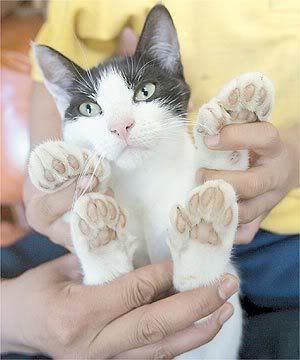 Her human family noticed there was something different with the three-month-old kitten when she started scratching more than other cats.
"You would sort of want to wear boxing gloves when you play with her," says Kaelene Gerrard, who lives with her partner Eli Eliu and daughters Mercy, six, and 12-year-old Shardae.
She examined the frisky feline's paws and did a double take at what she found.
"We counted and then recounted but we had it right the first time," she says.
Extra has seven toes on each front paw and six toes on each back paw - instead of the normal five on each.
"Her mum Star is a normal cat but her grandmother had six toes on each paw as well and so does her brother. But we've never even heard of a kitten with seven toes on each front paw," says Kaelene.
"Extra's a good climber and runs really fast.
(via)
Her human family noticed there was something different with the three-month-old kitten when she started scratching more than other cats.
"You would sort of want to wear boxing gloves when you play with her," says Kaelene Gerrard, who lives with her partner Eli Eliu and daughters Mercy, six, and 12-year-old Shardae.
She examined the frisky feline's paws and did a double take at what she found.
"We counted and then recounted but we had it right the first time," she says.
Extra has seven toes on each front paw and six toes on each back paw - instead of the normal five on each.
"Her mum Star is a normal cat but her grandmother had six toes on each paw as well and so does her brother. But we've never even heard of a kitten with seven toes on each front paw," says Kaelene.
"Extra's a good climber and runs really fast.
(via)
Letting the Cat out of the Bag
 Checkers Drive-In Restaurants recently re-released a commercial starring a rapping feline named, of course, RapCat.
When it was first released last Fall, it was an "overnight success", according to a Checker's spokesman.
RapCat has his own official website at http://www.rap-cat.com where you can get RapCat merchandise (coming soon), download RapCat themed goodies, read RapCat's bio, and watch RapCat's Music Video World Premiere on March 5th!
What's the problem?
The Tampa, Florida-based, fast-food company has a special take-out bag with cutaways for a cat's legs and tail. Checkers is encouraging customers to dress-up their cats with the bag, which is designed to look like a basketball jersey.
Hillsborough County Animal Services has issued an advisory asking people not to put their cats into the bags. Their fear is that a cat or cat owner will be hurt stuffing a cat into one of the bags. The department also stated in a news release that if someone does force a cat into a bag, they could be charged with animal cruelty. A First Offense comes with a stiff $300 fine and arrest.
(photo credit)
Checkers Drive-In Restaurants recently re-released a commercial starring a rapping feline named, of course, RapCat.
When it was first released last Fall, it was an "overnight success", according to a Checker's spokesman.
RapCat has his own official website at http://www.rap-cat.com where you can get RapCat merchandise (coming soon), download RapCat themed goodies, read RapCat's bio, and watch RapCat's Music Video World Premiere on March 5th!
What's the problem?
The Tampa, Florida-based, fast-food company has a special take-out bag with cutaways for a cat's legs and tail. Checkers is encouraging customers to dress-up their cats with the bag, which is designed to look like a basketball jersey.
Hillsborough County Animal Services has issued an advisory asking people not to put their cats into the bags. Their fear is that a cat or cat owner will be hurt stuffing a cat into one of the bags. The department also stated in a news release that if someone does force a cat into a bag, they could be charged with animal cruelty. A First Offense comes with a stiff $300 fine and arrest.
(photo credit)
Pets in America: The Story of Our Lives with Animals at Home
 Americans are passionate about their pets, so much so that two-thirds of American households own at least one animal. "Pets in America: The Story of Our Lives with Animals at Home,” on view at the National Heritage Museum March 31 through October 14, 2007, is a charming and informative exhibition exploring our relationships with the furry, feathered, and sometimes scaly creatures we hold dear.
"Pets in America” will feature more than 200 objects and photographs including pet portraits from the 1800s, a dog treadmill from the 1890s, early veterinary medicines, vintage pet food packaging, antique collars, birdcages, aquariums, and print ads. The objects are drawn from public and private collections across the nation. The exhibition explores American love of the company of animals, and how this relationship has changed as our country and culture have evolved.
The exhibition also has a companion web site, which provides a virtual tour. It can be accessed at www.PetsinAmerica.org.
Americans are passionate about their pets, so much so that two-thirds of American households own at least one animal. "Pets in America: The Story of Our Lives with Animals at Home,” on view at the National Heritage Museum March 31 through October 14, 2007, is a charming and informative exhibition exploring our relationships with the furry, feathered, and sometimes scaly creatures we hold dear.
"Pets in America” will feature more than 200 objects and photographs including pet portraits from the 1800s, a dog treadmill from the 1890s, early veterinary medicines, vintage pet food packaging, antique collars, birdcages, aquariums, and print ads. The objects are drawn from public and private collections across the nation. The exhibition explores American love of the company of animals, and how this relationship has changed as our country and culture have evolved.
The exhibition also has a companion web site, which provides a virtual tour. It can be accessed at www.PetsinAmerica.org.
Dancing doggies
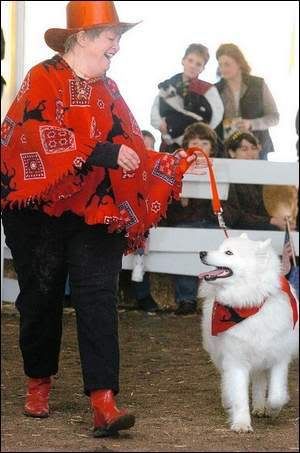 Canine freestyle: where humans and dogs do-si-do for fame and glory and wear cool costumes.
In the growing sport, human and dog become a dancing duo, dress in over-the-top costumes and show off their fancy footwork using all six of their legs to songs of all genres, from country to disco to classical masterpieces.
The sport has invaded canine culture in America, including doggie daycares, kennels and boarding facilities.
Dog owners and their pets don't cut the carpet just for exercise. Many try to perfect their routines to win competitions around the nation and worldwide. Colorado will be the site for two competitions this year being held by the World Canine Freestyle Organization, including the group's international titling contests that will take place in July.
Canine freestyle: where humans and dogs do-si-do for fame and glory and wear cool costumes.
In the growing sport, human and dog become a dancing duo, dress in over-the-top costumes and show off their fancy footwork using all six of their legs to songs of all genres, from country to disco to classical masterpieces.
The sport has invaded canine culture in America, including doggie daycares, kennels and boarding facilities.
Dog owners and their pets don't cut the carpet just for exercise. Many try to perfect their routines to win competitions around the nation and worldwide. Colorado will be the site for two competitions this year being held by the World Canine Freestyle Organization, including the group's international titling contests that will take place in July.
Tuesday, February 20, 2007
Monday, February 19, 2007
Ancient Tree Frog Found Encased in Amber
 A miner from Mexico's Chiapas state has made the find of a lifetime—a tiny tree frog preserved in amber that could be 25 million years old.
The block of amber, or fossilized tree resin, encasing the 0.4-inch (1-centimeter) frog was unearthed in 2005 and sold to a private collector, according to the Associated Press (AP). The collector then lent the piece—seen in this photo released on February 14—to scientists.
The specimen appears to belong to the genus Craugastor, said Gerardo Carbot, of the Chiapas Natural History and Ecology Institute, who has been studying the find. This genus includes many modern frogs native to Central America.
A miner from Mexico's Chiapas state has made the find of a lifetime—a tiny tree frog preserved in amber that could be 25 million years old.
The block of amber, or fossilized tree resin, encasing the 0.4-inch (1-centimeter) frog was unearthed in 2005 and sold to a private collector, according to the Associated Press (AP). The collector then lent the piece—seen in this photo released on February 14—to scientists.
The specimen appears to belong to the genus Craugastor, said Gerardo Carbot, of the Chiapas Natural History and Ecology Institute, who has been studying the find. This genus includes many modern frogs native to Central America.
Bloodhounds on the trail to extinction
 For generations the bloodhound has been a faithful friend. Now, however, it is being pushed to the brink of extinction, by a celebrity-led trend for new crossbreeds.
It is one of a number of traditional breeds fighting for survival as owners opt for toy dogs such as labradoodles and puggles.
New figures for the number of pedigree pups born have alarmed breeders as they show 24 breeds below the benchmark deemed viable for a healthy long-term population.
The Skye and Glen of Imaal terriers, the field spaniel and the smooth collie are among them.
"It all seems to be about fashion," said Julien Barney, of the British and Irish Dog Breeds Preservation Trust. "But the breeds that need help are the rare ones that are just as unusual."
Breeders reckon that a birthrate of 300 puppies a year is needed to guarantee a large gene pool and a long term, healthy population, but 10 breeds had less than 100 puppies in the last year.
The lowest birth rate was among Glen of Imaal terriers, which had 41 puppies, while 51 otterhounds were born.
(via)
For generations the bloodhound has been a faithful friend. Now, however, it is being pushed to the brink of extinction, by a celebrity-led trend for new crossbreeds.
It is one of a number of traditional breeds fighting for survival as owners opt for toy dogs such as labradoodles and puggles.
New figures for the number of pedigree pups born have alarmed breeders as they show 24 breeds below the benchmark deemed viable for a healthy long-term population.
The Skye and Glen of Imaal terriers, the field spaniel and the smooth collie are among them.
"It all seems to be about fashion," said Julien Barney, of the British and Irish Dog Breeds Preservation Trust. "But the breeds that need help are the rare ones that are just as unusual."
Breeders reckon that a birthrate of 300 puppies a year is needed to guarantee a large gene pool and a long term, healthy population, but 10 breeds had less than 100 puppies in the last year.
The lowest birth rate was among Glen of Imaal terriers, which had 41 puppies, while 51 otterhounds were born.
(via)
Wild pigs in Hong Kong pose pesky problem to villagers
 The Year of the Pig is upon us but not everyone is welcoming the porcine animal, which represents conspicuous consumption and good fortune to the Chinese.
Hong Kong villages are being plagued by wild pigs being a nuisance, and destroying crops.
Just a distance away from the residential district of Fanling, a village in the New Territories has a pesky problem.
Head Villager Jody Au-Yeung says her village has suffered an alarming rate of wild boar sightings, and claims six pet dogs have died as a result.
Villagers have had their crops destroyed.
"They step all over, dig up and destroy some of my flowers," says a flower farmer.
It has left some feeling unsafe, and there've been requests that the authorities do more to eradicate the problem.
The Year of the Pig is upon us but not everyone is welcoming the porcine animal, which represents conspicuous consumption and good fortune to the Chinese.
Hong Kong villages are being plagued by wild pigs being a nuisance, and destroying crops.
Just a distance away from the residential district of Fanling, a village in the New Territories has a pesky problem.
Head Villager Jody Au-Yeung says her village has suffered an alarming rate of wild boar sightings, and claims six pet dogs have died as a result.
Villagers have had their crops destroyed.
"They step all over, dig up and destroy some of my flowers," says a flower farmer.
It has left some feeling unsafe, and there've been requests that the authorities do more to eradicate the problem.
Tasmanian devils face extinction from mutant cancer
 A mutant cancer which causes facial tumours on Australia's Tasmanian devil has brought the carnivorous marsupial to the brink of extinction, a leading researcher has said.
Local populations of the animal, popularised as Taz by Warner Bros. in its Looney Tunes cartoons, have already been savaged by the mysterious disease which results in malignant facial tumours.
Hamish McCallum, professor of wildlife research at the University of Tasmania's school of zoology, said the disease, which usually results in death six months after the appearance of the first lesions, could lead to the extinction of the species within a decade.
"I won't say that it's the most likely outcome but I think at this stage there is an unacceptable risk that we may lose all populations on mainland Tasmania," he told AFP Monday. "And I think probably in the next 10 years."
A mutant cancer which causes facial tumours on Australia's Tasmanian devil has brought the carnivorous marsupial to the brink of extinction, a leading researcher has said.
Local populations of the animal, popularised as Taz by Warner Bros. in its Looney Tunes cartoons, have already been savaged by the mysterious disease which results in malignant facial tumours.
Hamish McCallum, professor of wildlife research at the University of Tasmania's school of zoology, said the disease, which usually results in death six months after the appearance of the first lesions, could lead to the extinction of the species within a decade.
"I won't say that it's the most likely outcome but I think at this stage there is an unacceptable risk that we may lose all populations on mainland Tasmania," he told AFP Monday. "And I think probably in the next 10 years."
Stumpy
 Webbed feet run in Stumpy's family, but he's the first to have four of them.
A rare mutation has left the eight-day-old duckling with two nearly full-sized legs behind the two he runs on. Nicky Janaway, a duck farmer in New Forest, Hampshire, 95 miles southwest of London, showed the duckling to reporters Saturday.
"It was absolutely bizarre. I was thinking 'he's got too many legs' and I kept counting 'one, two, three, four,'" Janaway said.
Stumpy would probably not survive in the wild, but Janaway, who runs the Warrawee Duck Farm in New Forest, says he is doing well.
"He's eating and surviving so far, and he is running about with those extra legs acting like stabilizers," Janaway said.
The mutation is rare, but cases have been recorded across the world. One duckling named Jake was born in Queensland, Australia, in 2002 with four legs but died soon after.
Webbed feet run in Stumpy's family, but he's the first to have four of them.
A rare mutation has left the eight-day-old duckling with two nearly full-sized legs behind the two he runs on. Nicky Janaway, a duck farmer in New Forest, Hampshire, 95 miles southwest of London, showed the duckling to reporters Saturday.
"It was absolutely bizarre. I was thinking 'he's got too many legs' and I kept counting 'one, two, three, four,'" Janaway said.
Stumpy would probably not survive in the wild, but Janaway, who runs the Warrawee Duck Farm in New Forest, says he is doing well.
"He's eating and surviving so far, and he is running about with those extra legs acting like stabilizers," Janaway said.
The mutation is rare, but cases have been recorded across the world. One duckling named Jake was born in Queensland, Australia, in 2002 with four legs but died soon after.

